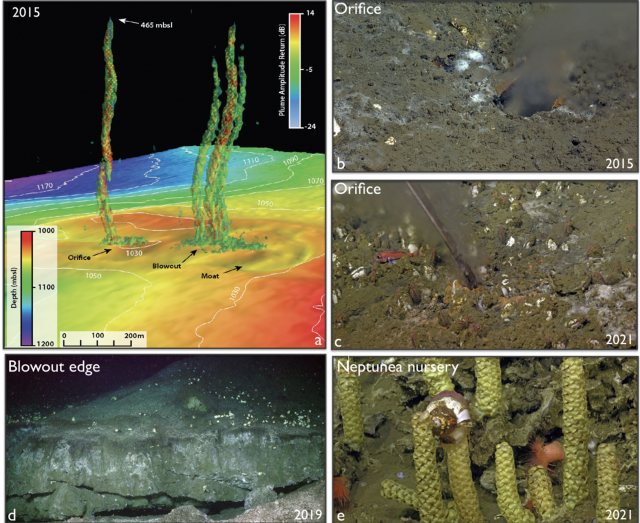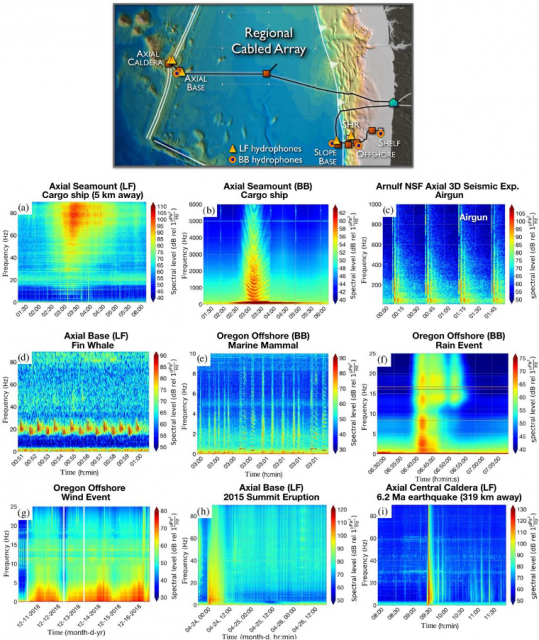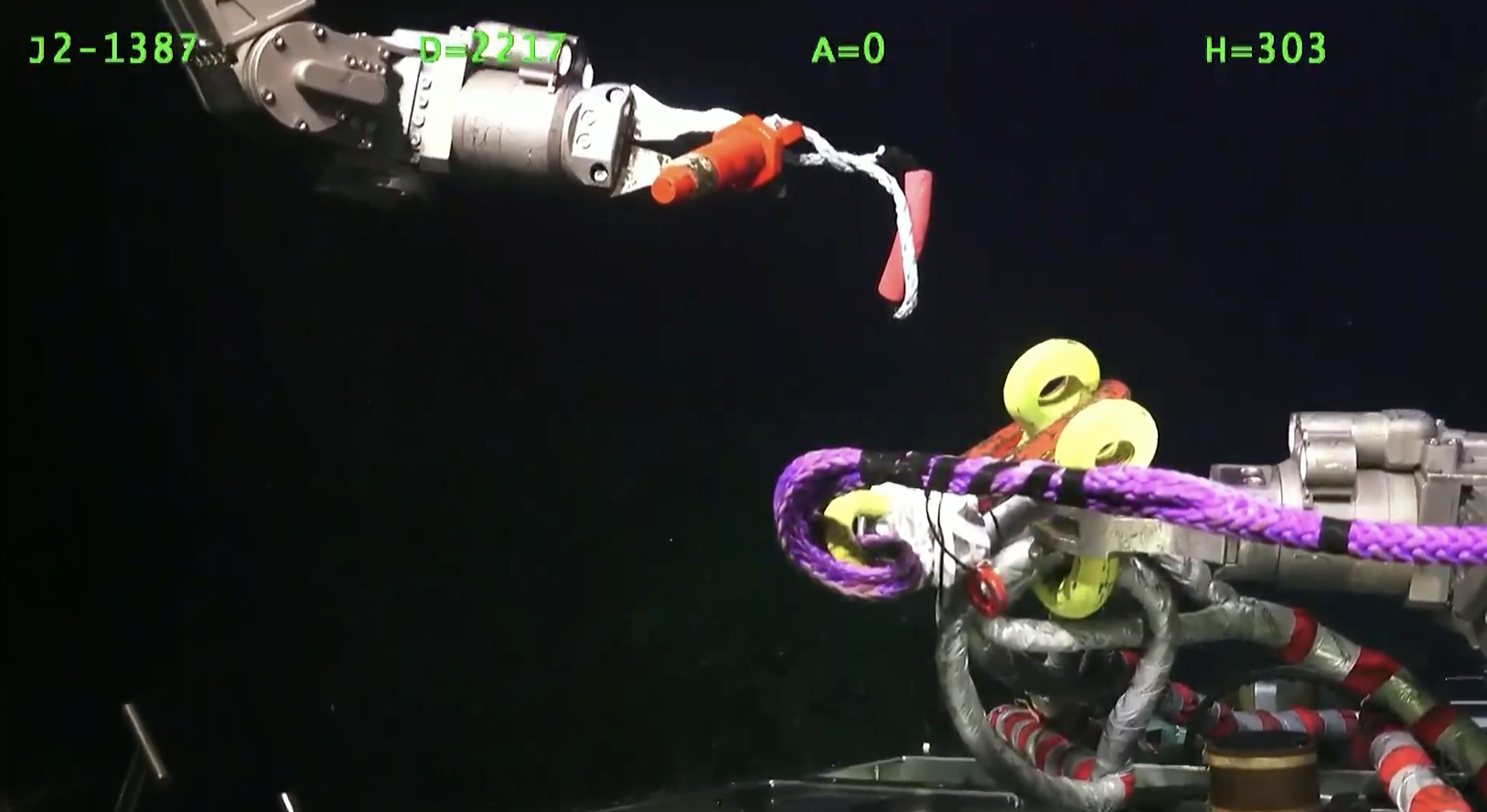Posts Tagged ‘Regional Cable’
Pythias Oasis: The First-of-Its-Kind Seep in the Oceans
Adapted and condensed by OOI from Philip, et al., 2023, doi: 10.1126/sciadv.add6688.
[media-caption path="/wp-content/uploads/2023/01/Screen-Shot-2023-01-26-at-10.21.55-AM.png" link="#"] a) A multibeam sonar image of the methane bubble plumes at Pythias Oasis in 2015. b) Pythias orifice in 2015 showing the fluid-dominated, sediment-rich plume, as first visualized on the discovery dive by the ROV ROPOS. The main orifice has been continuously active since 2015. c) Pythias’ orifice in 2021 with increased biological communities and a small Fe-rich chimney. d) The edge of a large collapse-blowout zone – coring across this area in 2019 recovered substantial methane hydrate. e) A Neptunea snail nursery between the orifice site and the blowout zone.[/media-caption]Pythias Oasis is the first-of-its-kind seep in the oceans, providing a window into controls on megathrust events along the Cascadia Margin. Pythias Oasis, discovered during the 2015 Regional Cabled Array (RCA) Operations and Maintenance Cruise, utilizing the hull-mounted sonar on the R/V Thompson, is unlike any seep site yet described along active margins with unprecedented fluid chemistries (Figure above). It hosts an intense fluid-dominated venting system issuing low-salinity, hydrocarbon-bearing fluids carrying low concentrations of suspended particles from a discrete orifice that has been continuously active since 2015. Detailed sampling, as part of an NSF OCE-funded expedition in 2019 (OCE 16582901), and another dive in 2021 (added onto the RCA 2021 cruise) show that the fresh, warm fluids (four times background temperatures) are venting at the highest discharge rates yet measured within the Cascadia Subduction Zone (CSZ) and that the fluids are extremely enriched in boron lithium and iron.
Pythias Oasis provides a rare window into processes acting deep in the margin with fluid chemistries indicating that the fluids are sourced near the plate boundary in the Central CSZ at minimum temperatures of 150-250°C. The high discharge rates are thought to reflect draining of fluids along an over-pressurized reservoir associated with the subduction zone-perpendicular Alvin Canyon strike slip fault, suggesting that the faults regulate pore fluid pressure and megathrust slip behavior along the Central CSZ.
Results from this work are presented in Philip, B.T., E.A. Solomon, D.S. Kelley, A.M. Tréhu, T.L. Whorley, E. Roland, M. Tominaga, and R.W. Collier (2023) Fluid sources and overpressures within the central Cascadia Subduction Zone revealed by a warm, high-flux seafloor seep. Science Advances (9), doi: 10.1126/sciadv.add6688.
Read MoreAn Overview of Ambient Sound Using OOI Hydrophones
Adapted and condensed by OOI from Ragland, et al., 2022, doi.org/10.1121/10.0009836.
[media-caption path="/wp-content/uploads/2022/11/RCA-highlight.png" link="#"]Figure 1: Highlights of acoustic features from the five low frequency (Fs=200Hz) and six broadband (Fs = 64 kHz) hydrophones on the RCA.[/media-caption]Ragland et al., (2022) provides a wonderful overview of the unique opportunities for data and experimentally driven advancements in acoustics that are provided by (long-term) ambient sound recordings streamed live from hydrophones on the Regional Cabled Array. Figure 1, above (after Figure 5, Ragland et al., 2022), highlights acoustic features from the five low frequency (Fs=200Hz) and six broadband (Fs = 64 kHz) hydrophones on the RCA. Areas of research span the rare ability to conduct offshore monitoring of Fin whale migration, and the seasonal fluctuations and decade-long evolution of their calls, in situ offshore meteorological measurements with high temporal resolution to study wind and rain noise in the NE Pacific, the sound from commercial ships with impacts on the oceanic environment and marine life, ambient noise interferometry, volcanic eruptions, and both local and far-field earthquakes. As the authors note, the RCA-OOI data also provide significant opportunities for the development of machine learning tools for ocean acoustics. This work was supported by an award from the Office of Navy Research. The authors developed a public Python package (OOIPy) to access and explore the hydrophone data more easily (Schwock et al., 2021). OOIPy is also accessible through the OOI website tab Community Tools and Datasets.
__________________________________________________________
Ragland, J., F. Schwock, M. Munson, and S. Abadi (2022) Journal of the Acoustic Society of America, 151, 2085-2100, https://doi.org/10.1121/10.0009836.
Schwock, F., J. Ragland, L. Setiawan, M. Munson, D. Volodin, and S., Abadi (2021). OOIPY v1.1.3: A Python toolbox designed to aid in the scientific analysis of Ocean Observatories Initiative data, https://doi.org/10.5281/zenodo.5889288.
Read More
RCA Cruise Turns Toward Recovery Operation
The Regional Cabled Array team successfully completed its annual operations and maintenance cruise and was supposed to be back in port September 2. The R/V Thompson and ROV Jason, however, were called on to assist the E/V Nautilus recover its two ROVs Hercules and Argus. Don’t miss the remarkable opportunity to watch this operation live http://nautiluslive.org/.
The two ROVs were successfully recovered. After a 26-hour diversion, the Thompson headed back to port for the official end of the RCA expedition.
Read More


